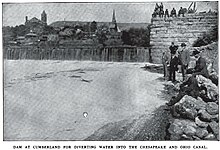| Cumberland Dam | |
|---|---|
 | |
| Country | United States |
| Location | Cumberland, Maryland |
The Cumberland Dam was a dam that was built across North Branch of the Potomac River in Cumberland, Maryland, for the purpose of diverting water from the river into the head of the Chesapeake and Ohio Canal. The Chesapeake and Ohio Canal Company began construction of Dam No. 8 in 1837 and work proceeded intermittently, finally concluding in 1850. The dam impounded water over a distance of a mile, causing back water for about 3 miles (4.8 km) up the river. Above the dam is the mouth of Wills Creek.
Environmental impact
| This section does not cite any sources. Please help improve this section by adding citations to reliable sources. Unsourced material may be challenged and removed. Find sources: "Cumberland Dam" – news · newspapers · books · scholar · JSTOR (August 2023) (Learn how and when to remove this message) |
In the early 1900s Wills Creek received a large quantity of industrial sewage and refuse from a paper mill, a brewery, a distillery, a cement works, a tannery, dye works, a gas plant, and a number of coal mines. Furthermore, in the early 1900s the city of Cumberland supplied 2,500,000 US gallons (9,500 m) of water and discharged 1,000,000 US gallons (3,800 m) per day into Wills Creek. As expected, these pollutants accumulated in the pond above the dam as if in a settling basin, especially during seasons of low water when no water passed over the crest of the dam.
About 400 yards (370 m) above the dam was the intake of the Cumberland waterworks, where the city's water was pumped from the river directly into the water mains and was served to the inhabitants without being purified through filter beds or other artificial means. Complaints arose yearly prior to 1900 during the dry season, when the water, besides being unpalatable, was scarcely clean enough for laundering purposes. Of the large percentage of impurities which the water contained at such times, a portion was composed of sewage from the city that had backed up to the point of intake of the dam.
Much has changed since 1900 to eliminate these problems. The city's economy has made a significant transition away from manufacturing and coal production. The city's water is filtered and obtained from other water supplies. The city’s sewage is now treated before being discharged.
References
- Unrau, Harland D. (2007) . Gray, Karen M. (ed.). Historic Resource Study: Chesapeake & Ohio Canal (PDF). Hagerstown, MD: U.S. National Park Service.
- Newell, F.H. (1900). "The Hydrography of Allegany County". Maryland Geological Survey: Allegany County. Baltimore: Johns Hopkins Press. p. 250. hdl:2027/uiug.30112070501728.
39°38′54.5″N 78°45′56.5″W / 39.648472°N 78.765694°W / 39.648472; -78.765694
Categories: